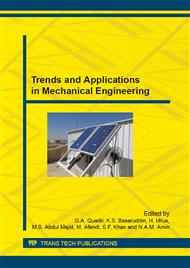p.383
p.388
p.393
p.398
p.404
p.409
p.415
p.421
p.426
Reverse Engineering and Structural Analysis of Radiator Fan Blades
Abstract:
The function of the fan is to reduce heat in the radiator where hot cooling liquid is circulated. The radiator fan blades are made up of various materials nowadays and the legacy material used is steel. This paper presents the static analysis of the radiator fan and at the outcome we analyze the failure of the entire blade taking into design consideration. The analysis of the radiator fan is executed to different types of materials to check and evaluate the material and process conditions which withstand the dynamic and structural loads. In the paper design of the blade is done through reverse engineering. The static analysis is done using ANSYS where the 3D solid model of the radiator fan is considered for structural analysis. The various loads and properties and applied through the entire length of the radiator fan. The analysis leads us to proposal of suitable material to withstand all the loads. The Fiber Reinforced Plastic (FRP) material is tested and considered.
Info:
Periodical:
Pages:
404-408
Citation:
Online since:
August 2015
Authors:
Keywords:
Price:
Сopyright:
© 2015 Trans Tech Publications Ltd. All Rights Reserved
Share:
Citation:


